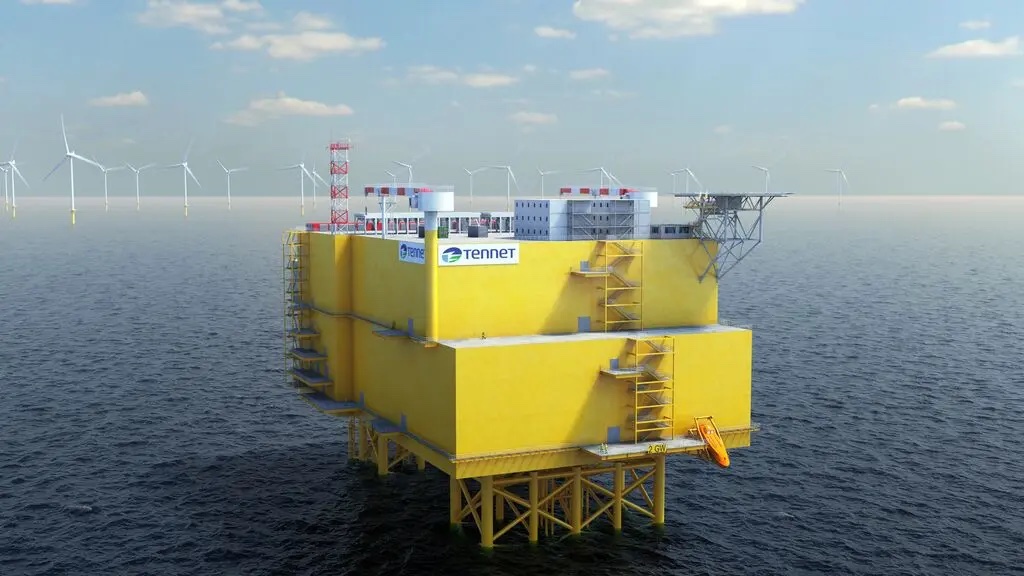Tokyo (SCCIJ) – Hitachi Energy, the former power grid business of the Swiss conglomerate ABB, has concluded the largest framework agreement in its history worth 13 billion euros. This deal proves that the huge Japanese-Swiss M&A transaction between Hitachi and ABB is turning out as a big success.

Hitachi and Petrofac will supply converter stations for a 2GW offshore platform © TenneT).
Offshore wind power
More specifically, TenneT, the Dutch-German transmission system operator, has selected Hitachi Energy and Petrofac to supply multiple offshore and onshore HVDC converter stations and associated infrastructure to accelerate the integration of bulk renewables into European power grids. Hitachi Energy and Petrofac were awarded the multi-year framework agreement as part of TenneT’s ambitious offshore wind “2GW Program”.
The agreement includes an initial commitment to deploy six record-breaking renewable integration systems, five of which will connect offshore wind farms to the Dutch grid and the sixth to the German grid. Each of these connection systems has a capacity of 2 gigawatts
(GW) and a voltage level of 525 kilovolts (kV) – a world-first for offshore wind.
Hitachi Energy will supply its HVDC Light converter stations, which convert AC to DC power offshore and DC to AC onshore. This proprietary technology is originally Swiss. Petrofac will undertake the engineering, procurement, construction, and installation of the offshore platforms and elements of the onshore.
The landmark framework agreement is the largest ever for Hitachi Energy. It confirms the opportunity to innovate how state-of-the-art technology can be deployed effectively and how new business models enable the scale needed for the green energy transition.
“This innovative business model will set the course for the integration of a huge amount of offshore wind power and gives visibility of the future. We are already hiring to expand our global delivery capacity and effectively fulfill these and other orders,” said Niklas Persson, Managing Director at Hitachi Energy’s Grid Integration business.
Swiss base
Headquartered in Switzerland, Hitachi Energy employs around 40,000 people in 90 countries and generates business volumes of approximately 10 billion dollars. Hitachi’s acquisition of the ABB power grid business announced in December 2018 was the largest in its corporate history. “Our evolution into a global market leader is progressing,” said CEO Toshiaki Higashihara at that time.
Hitachi paid 704 billion yen for 80% of this particular ABB business and acquired the remaining 20% in 2021. After starting operations in July 2020, the new company changed its name from “Hitachi ABB Power Grids” to “Hitachi Energy” in October 2021. ABB sold its remaining stake of 19.9% at the end of 2022 when Hitachi exercised its call option. ABB registered a positive cash flow of 1,45 million dollars.
The Hitachi Group, with well over 800 units, number four in Japan in terms of sales, is known outside Japan for televisions and electrical appliances but primarily supplies companies with electrical and medical equipment and technology. The growth hopes of the Japanese conglomerate rest on businesses around “social innovations”. This term primarily means power plants, railroads, electric cars, smart cities, and factory automation.
The researchers achieved all this by equipping the ornithopter with a full onboard computer and navigation system, which was complemented by an external motion-capture system to help it determine its position. The claw itself was designed to absorb the robot’s forward momentum upon impact and to close quickly and firmly to support its weight. Once perched, the robot remains on the perch without energy expenditure.
Looking ahead, Zufferey is already thinking about how their device could be expanded and improved, especially in an outdoor setting. “At the moment, the flight experiments are carried out indoors, because we need to have a controlled flight zone with precise localization from the motion capture system. In the future, we would like to increase the robot’s autonomy to perform perching and manipulation tasks outdoors in a more unpredictable environment.”
Text:SCCIJ partly based on material from Hitachi Energy





























